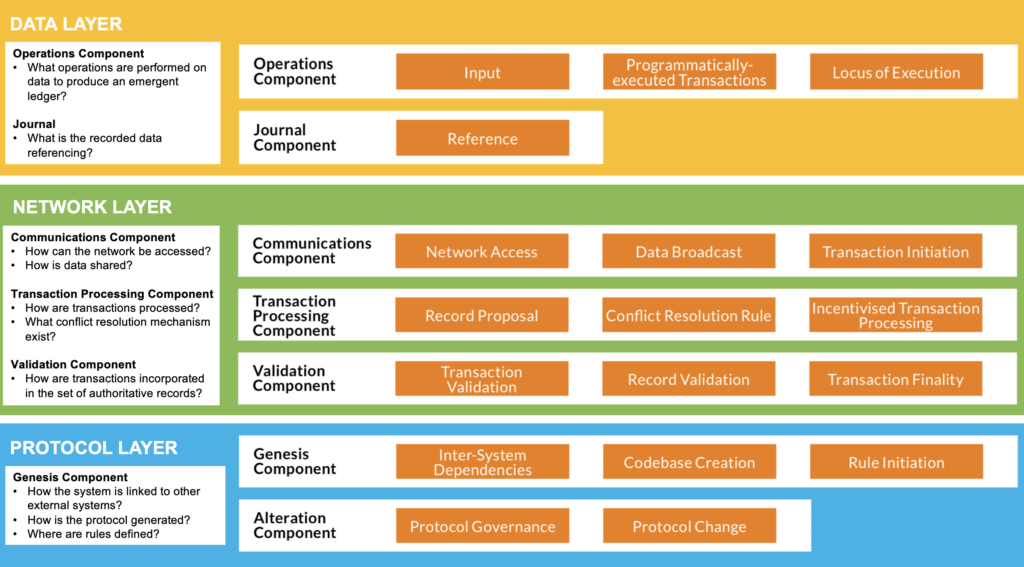
Defining and understanding what is blockchain is a difficult task in itself. Michel Rauchs published a white paper entitled “Distributed Ledger Technology Systems – A Conceptual Framework” whilst he was at the Cambridge Centre for Alternative Finance. to help clarify all the concepts in DLT systems and to provide a framework in understanding those systems.
About Michel Rauchs
Michel got interested in Bitcoin, cryptocurrencies, blockchain technologies about 5 years ago and then decided to write a master thesis about the evolution of the Bitcoin business ecosystem. For his thesis he monitored the evolution of this ecosystem by taking a data set of 500 different companies, projects and organisations over a 5 year period.
Joined the Cambridge Centre for Alternative Finance to work full time as a researcher of the blockchain and cryptocurrency ecosystem. He has now recently left the Cambridge Centre to set himself up as an independent consultant at Paradigma.
What is blockchain?
Michel concedes that answering this question could take a whole day. But for him a blockchain, or a DLT system as he prefers to call it, is essentially just a shared record keeping system that is collectively maintained and updated by multiple participants that may not necessarily trust each other. Participants are able to reach an agreement over shared set of data and its validity without the need for a central coordinator or central administrator.
With regards to differentiating the differences between DLT and blockchain it is very difficult as the terminology is very unclear, messy and fuzzy. At the moment they’re both used as umbrella terms for a wide array of different concepts and technologies.
Publishing the white paper “Distributed Ledger Technology Systems – A Conceptual Framework”
Michel had two objectives in publishing the white paper: “Distributed Ledger Technology Systems – A Conceptual Framework”:
- Clarify all the concepts that have been conflated together
- Provide a framework to divide the system into different parts, components and processes. To compare different systems together by analysing how different design configurations and decisions essentially impact the characteristics and properties of the systems
Public vs private blockchains and distributed systems.
The difference between DLT systems and other distributed systems, are that in traditional distributed systems you have distributed storage, processing power across multiple connected devices but connected by one entity to achieve fault tolerance. So, if one of these components or devices goes down, that the system as a whole still continues to function.
In DLT systems, it’s really about what is called Byzantine fault tolerance. So not only being able to cope with hardware failures but also with tolerating with the presence of potentially malicious actors that want to actively try to undermine or disrupt the network.
In public blockchains you have dynamic membership systems where anyone can join a network and leave the network at any point of time. It essentially means that we do not know at any point in time, how many actors on the system, and actually who they are.
Now, in private blockchains, it’s a bit different, because we have restricted access to a limited number of participants. A fixed membership system. It’s closed and restricted to certain type of participants. And as such the number of adversities you can have is a lot more limited.
Public blockchains are really complex socio-economic systems. Because anyone can join, anyone can leave, you don’t actually know how many people there are. So, the only way to essentially regulate that system, is via self-regulation through a combination of economic incentives and Game Theory.
Whereas in private blockchains, you have a more traditional business environment as all participants are known and vetted. In comparison to public blockchains, the security of private blockchains relies primarily on the legal system. The threat of taking legal actions in case an actor misbehaves
Key characteristics a DLT system needs to be capable of ensuring
In his report, Michel distilled five key characteristics an “ideal” DLT system:
- Shared recordkeeping: enable multiple parties to collectively create, maintain, and update a shared set of authoritative records or data.
- Multi-party consensus: enable all parties to write data to the system and to participate in the consensus process. To come to agreement on a shared set of records rather than relying on one single record producer.
- Independent validation: enable each participant to independently verify the state of their transactions and integrity of the system. Thus, there isn’t the need to rely on some trusted third party to actually tell you that what you see is, is correct.
- Tamper evidence: allow each participant to detect non-consensual changes applied to records, in a very trivial manner, to make it very easy for anyone to immediately notice if somebody has tampered with the data.
- Tamper resistance: make it hard for a single party to unilaterally change past records (i.e. transaction history).
Rise of the blockchain meme
In an upcoming study, due to be published in September 2019, that looks in detail at 70 live enterprise blockchain networks, that have been deployed in production, over 80% of them in their current form are actually very centralised. This invalidates 2 to 3 of the above key characteristics a DLT system needs to be capable of ensuring.
For some of these systems, there’s good reasons that they want to start initially centralised and then gradually distribute control over time. However, 77% of these systems do not have much in common with multi-party consensus. They just use some of the technology components such as cryptographic techniques, P2P or even simply the blockchain nomenclature. These kind of systems falls under what Michel’s report calls, blockchain meme category. These systems often leverage blockchain as a concept to act as a catalyst to drive organisational change. Change between two processes between enterprises regarding the underlying infrastructure that these different enterprises use to essentially exchange and share data with themselves.
Whilst these systems don’t quite fit into what Michel’s report would consider to be true DLT systems, that’s fine as most business environments don’t require them all. However, as the same terminology continues to be used across all of these systems it creates confusion on what is blockchain and DLT and it sets unrealistic expectations on what it can actually deliver.
In a blockchain meme, it gives companies the excuse to reconsider the way things have been done. It’s about starting to really disentangle everything and just integrate everything into different pieces and if there’s a way of doing things differently. This blockchain meme thus becomes a way to help solve political roadblocks that are there.
What is a ledger?
“Ledger” is a word we often hear in the blockchain space, however not much time is actually spent explaining what it is. Michel, defines it as the way that the data is essentially structured, so the way that people actually look at what is being recorded in the system.
Four actors in a DLT system
To simplify DLT systems there are four types of actors:
- Developers: provide the code base and the updates to the system.
- Administrators / operators: especially in private blockchains they are essentially actors that either operate the network or hold the IP of the networks and intellectual property rights.
- Gateways: in a public blockchain they can be exchanges, custodians or oracles. Gateways bridge the DLT system with the external world so that data can flow between the two.
- Network participants:the network consists of interconnected participants that communicate by passing messages among each other. Full nodes, auditors, those are the ones that validate transactions and actually share them with their peers.
Introducing the framework – three core layers
A DLT system can be divided into three interdependent core layers:
- Protocol: set of software-defined rules that determine how the system operates
- Network: interconnected actors and processes that implement the protocol
- Data: information flowing through the system that carries a specific meaning in relationship to the design and functions the system is intended to play for users
The protocol layer
The protocol layer is the foundation of the entire DLT system: it defines the set of formal rules that governs the system and codifies its architectural design. The protocol can be considered a set of ‘constitutional’ arrangements agreed upon by all system participants. The protocol contains two components:
- Genesis component: is before the system is actually started, this entire process is about who is involved in actually deciding the rules, what are the limitations, defining what are the rules and the boundaries.
- Alteration component: Sets out how the protocol evolves over time. It includes a governance aspect (i.e. how collective decisions are made) as well as an implementation consideration (i.e. how the result of those decisions are incorporated).
The network layer
Is the practical implementation of the protocol rules. The network layer is comprised of interconnected actors that collectively store, share, and process data. The network layer is the practical implementation of the protocol rules, describing how participants access the system, how data is shared within the network, how the ledger is updated, and how participants verify the validity of transactions and records. It contains three core components:
- Communications component – is all about how data is shared and who has the authorisation to initiate transactions
- Transaction processing (also known as transaction ordering): This is what’s called mining in public blockchains. Determines who is allowed to participate in the network consensus process. It’s about adding blocks and ordering them in the system.
- Validation component: Sets out the actions undertaken by each auditor to verify whether transactions and records conform to protocol rules, i.e. are valid and non-conflicting. This is a crucial aspect of a DLT system that provides nodes with the ability to verify independently what occurs within the system.
The data layer
The data layer is the information that’s processed and stored by the system in the form of records. It answers the fundamental question of what is stored in the blocks.
Michel highlights what’s important is the reference of what he calls the value linking of the data. So, whether it’s endogenous, meaning if the data we refers to things that are confined within the boundaries of the system itself.
For example, BTC only exists within the boundaries of the Bitcoin blockchain. It doesn’t exist outside. So, its very existence is defined by the ledger or the public Bitcoin blockchain. So that’s what is called endogenous data
Now you have the opposite of that, what is called exogenous data, or exogenous references. for example, a private blockchain that records events in and supply chain rights is essentially just to share record keeping system here that essentially needs to connect to the external world in order to get external data to essentially work with that.









